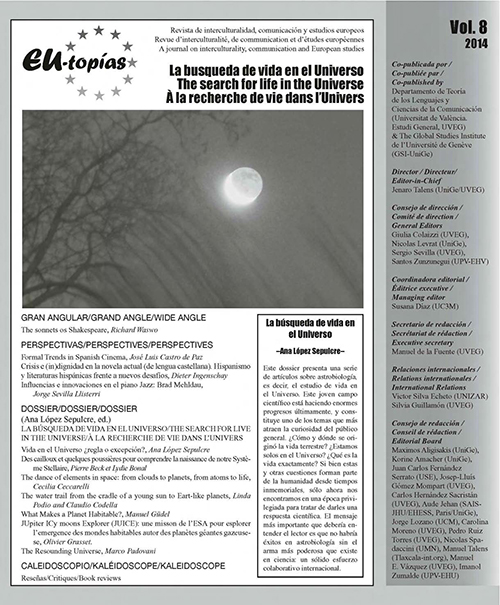What Makes a Planet Habitable?
DOI:
https://doi.org/10.7203/eutopias.0.18778Palabras clave:
Exoplanetas, habitabilidad, vida Resumen
Resumen
Antes de que la vida pueda surgir y desarrollarse en una superficie planetaria, son necesarias muchas condiciones de naturaleza astrofísica. La radiación y las partículas provenientes de la estrella central, el campo magnético del planeta, la acumulación o disipación de la atmósfera en un planeta joven, y varios otros factores deben actuar conjuntamente y de manera equilibrada para dar a la vida la oportunidad de florecer. En este artículo describimos estos prerrequisitos cruciales para la habitabilidad y exponemos el estado actual de nuestro conocimiento.
 Descargas
Descargas
 Citas
Citas
Feulner , Georg (2012) “The faint young Sun problem”, Reviews of Geophysics, 50, CiteID RG2006.
Elkins-Tanton , Linda T. (2008) “Linked magma ocean solidification and atmospheric growth for Earth and Mars”, Earth Planet. Sci. Lett., 271, pp. 181-191.
Grenfell , John L., et al. (2014) “Sensitivity of biosignatures on Earth-like planets orbiting in the habitable zone of cool M-dwarf stars to varying stellar UV radiation and surface biomass emissions”, Planet. Space Sci., 98, pp. 66-76.
Güdel , Manuel, et al. (2014) “Astrophysical Conditions for Planetary Habitability”. In Protostars and Planets VI, in press.
Kasting, James F. (1988) “Runaway and moist greenhouse atmospheres and the evolution of earth and Venus”, Icarus, 74, pp. 472-494.
Kasting, James F.; Whitmire , Daniel P.; Rey – nolds , Ray T. (1993) ”Habitable Zones around Main Sequence Stars”, Icarus, 101, pp. 108-128.
Kasting, James F.; Catling , D. (2003) “Evolution of a Habitable Planet”, Annu. Rev. Astron. Astrophys., 41, pp. 429-463.
Khodachenko , Maxim L., et al. (2012) “Magnetospheres of “Hot Jupiters”, Astrophys. J., 744, pp. 70-86.
Kislyakova , Kristina G., et al. (2013) “XUV-Exposed, Non-Hydrostatic Hydrogen-Rich Upper Atmospheres of Terrestrial Planets. Part II: Hydrogen Coronae and Ion Escape”, Astrobiol., 13, pp. 1030-1048.
Lammer , Helmut, et al. (2013) “Outgassing History and Escape of the Martian Atmosphere and Water Inventory”, Space Sci. Rev., 174, pp. 113-154.
Lammer , Helmut, et al. (2014) “Origin and loss of nebula- captured hydrogen envelopes from `sub’- to `super- Earths’ in the habitable zone of Sun-like stars”, Mon. Not. Roy. Astron. Soc., 439, pp. 3225-3238.
Lang, Kenneth (1999) Astrophysical Formulae, New York: Springer.
Mayor , Michel; Queloz , Didier (1995) “A Jupitermass companion to a solar-type star”, Nature, 378, pp. 355-359.
Ribas , Ignasi; Guinan, Edward F.; Güdel , Manuel; Audard , Marc (1995) “Evolution of the Solar Activity over Time and Effects on Planetary Atmospheres”, Astrophys. J., 622, pp. 680-694.
Rondanelli , Roberto; Lindzen , Richard S. (2010) “Can thin cirrus clouds in the tropics provide a solution to the faint young Sun paradox?” J. Geophys. Res., 115, D02108.
Sackmann, I.-Juliana; Boothroyd , Arnold I. (2003) “Our Sun. V. A Bright Young Sun Consistent with Helioseismology and Warm Temperatures on Ancient Earth and Mars”, Astrophys. J., 583, pp. 1024- 1039.
Wagner , Frank W. (2011) “Interior structure models of solid exoplanets using material laws in the infinite pressure limit”, Icarus 214, pp. 366-376.
Wood , Brian E. (2004) “Astrospheres and Solar-like Stellar Winds”, Liv. Rev. Solar Phys., 1, no 2.
Descargas
Publicado
Cómo citar
-
Resumen182
-
PDF 67
Número
Sección
Licencia
![]()
Las personas autores conservan los derechos de autor/a. Todos los contenidos publicados en EU-topías. Revista de interculturalidad, comunicación y estudios europeos están sujetos a la licencia Creative Commons Reconocimento-NoComercia-Compartirigual 4.0 cuyo texto completo puede consultar en <http://creativecommons.org/licenses/by-nc-sa/4.0>
Se pueden copiar, usar, difundir, transmitir y exponer públicamente, siempre que:
- Se cite la autoría y la fuente original de su publicación (revista, editorial y URL de la obra).
- No se usen para fines comerciales.
- Se mencione la existencia y especificaciones de esta licencia de uso.
Es responsabilidad de los autores y las autoras obtener los permisos necesarios de las imágenes que están sujetas a derechos de autor.



